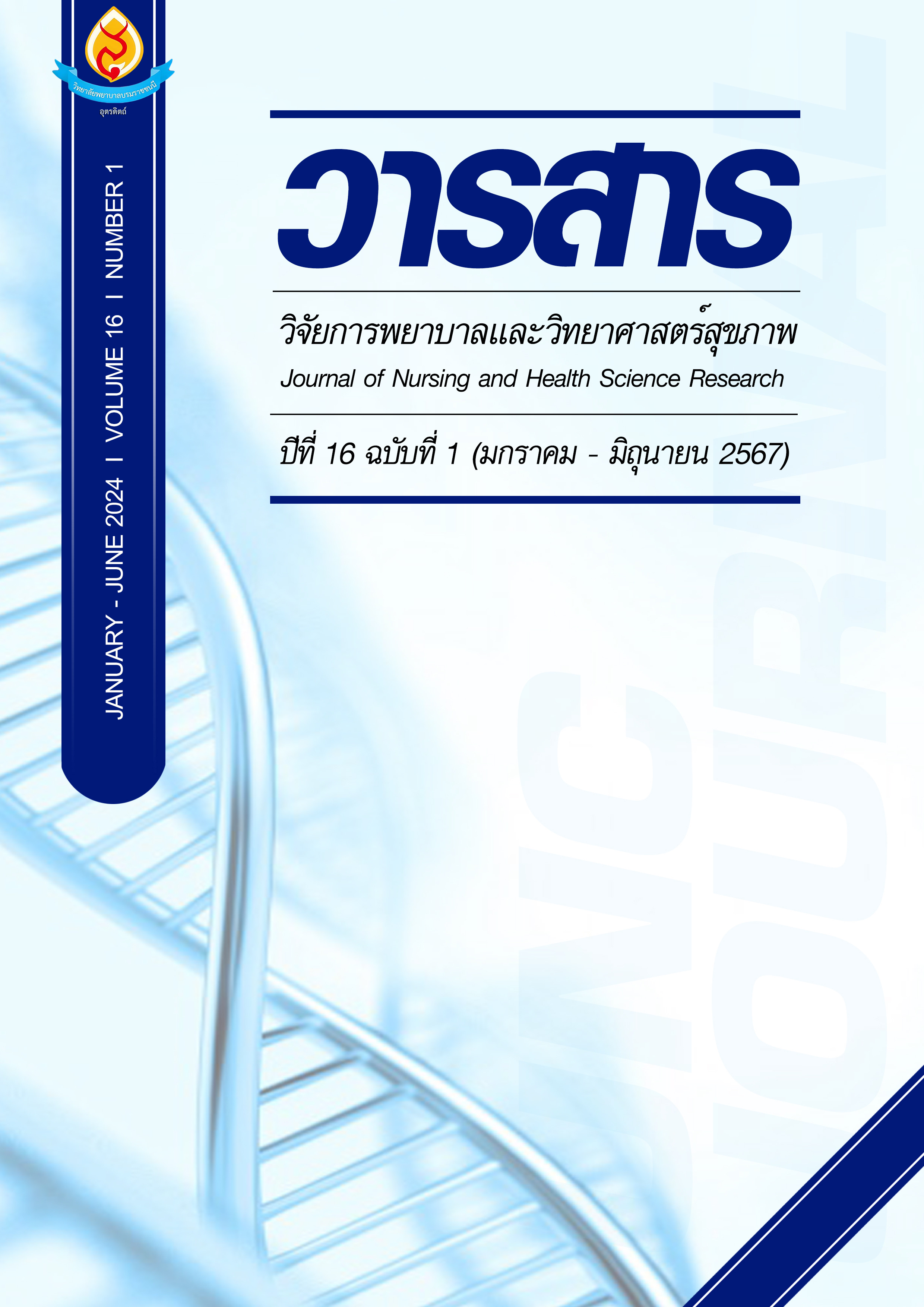การพัฒนารูปแบบการป้องกันการพลัดตกหกล้มโดยการมีส่วนร่วมในชุมชนของผู้สูงอายุที่มีข้อเข่าเสื่อมในชุมชน
Main Article Content
บทคัดย่อ
การศึกษาวิจัยเชิงพัฒนานี้มีวัตถุประสงค์เพื่อศึกษารูปแบบการป้องกันการพลัดตกหกล้มโดยการมีส่วนร่วมในชุมชนของผู้สูงอายุที่มีข้อเข่าเสื่อมในชุมชน และศึกษาประสิทธิผลของการใช้รูปแบบที่พัฒนาขึ้น
มีการดำเนินการ 3 ระยะ ได้แก่ 1) วิเคราะห์สถานการณ์ 2) การพัฒนารูปแบบการป้องกันการพลัดตกหกล้ม 3) ประเมินผลรูปแบบ โดยศึกษาจากผู้สูงอายุที่มีข้อเข่าเสื่อมในชุมชน 80 ราย มีกลุ่มทดลองและกลุ่มควบคุม กลุ่มละ 40 ราย เครื่องมือที่ใช้ในการวิจัย ได้แก่ 1) แบบประเมินความรุนแรงของอาการข้อเข่าเสื่อม 2) แบบประเมินการทรงตัว 3) แบบประเมินพฤติกรรมการป้องกันการหกล้ม 4) รูปแบบการป้องกันการพลัดตกหกล้ม วิเคราะห์ข้อมูลโดยใช้สถิติเชิงพรรณนา independent sample t-test และ repeated measures ANOVA.
ผลวิจัยพบว่ากลุ่มทดลองมีค่าเฉลี่ยคะแนนการทรงตัวและพฤติกรรมการป้องกันการป้องกันการพลัดตกหกล้มเพิ่มขึ้น และมีค่าเฉลี่ยคะแนนความรุนแรงของอาการข้อเข่าเสื่อมลดลงมากกว่าก่อนการทดลอง และกลุ่มควบคุมในสัปดาห์ที่ 8 และ 12 อย่างมีนัยสำคัญทางสถิติ (p<.05) ถึงแม้ว่ารูปแบบป้องกันการพลัดตกหกล้มนั้นไม่สามารถทำให้เกิดการเปลี่ยนแปลงของการทรงตัวระหว่างกลุ่มอย่างมีนัยสำคัญทางสถิติแต่ในกลุ่มทดลองมีค่าเฉลี่ยคะแนนการทรงตัวที่เพิ่มขึ้นกว่าก่อนการทดลองเมื่อระยะเวลาผ่านไป
ดังนั้นบุคลากรทีมสุขภาพควรนำไปประยุกต์ใช้กับผู้สูงอายุที่มีข้อเข่าเสื่อมอย่างต่อเนื่องเพื่อป้องกันการพลัดตกหกล้มต่อไป
Article Details

อนุญาตภายใต้เงื่อนไข Creative Commons Attribution-NonCommercial-NoDerivatives 4.0 International License.
บทความหรือข้อคิดเห็นใดใดที่ปรากฏในวารสารวิจัยการพยาบาลและวิทยาศาสตร์สุขภาพ เป็นวรรณกรรมของผู้เขียน ซึ่งบรรณาธิการหรือสมาคมศิษย์เก่า ไม่จำเป็นต้องเห็นด้วย และบทความที่ได้รับการตีพิมพ์เผยแพร่ถือเป็นลิขสิทธิ์ของวารสารวิจัยการพยาบาลและวิทยาศาสตร์สุขภาพ
เอกสารอ้างอิง
Aksaranugraha, S. (2000). Modified WOMAC scale for knee pain. Journal of Thai Rehabilitation, 9(3), 82-85. (in Thai).
Bellamy, N. (1988). Validation study of WOMAC: a health status instrument for measuring clinically important patient-relevant outcomes following total hip or knee arthroplasty in osteoarthritis. Journal of Orthopaedic Rheumatology, 1, 95-108.
Compiranonth, T. (2006). The effect of health education programapplying the protective motivation theory of self care of osteoarthritis in Chonprathan Hospital. (master’s thesis). Srinakarinwirot University. (in Thai).
Chuaychan, T., Moolsart, S. & Heebthamai, D. (2018). The development of a management model for knee osteoarthritis in a community by collaboration between nurse practitioners and village health volunteers. Songklanagarind Journal of Nursing, 38(2), 43-59. (in Thai).
Cohen, J. M. & Uphoff, N. T. (1980). Participation's place in rural development: Seeking clarity through specificity. World development, 8(3), 213-235.
Daharn, T. & Duangrach, J. (2017). Development of a health care model for elderly by community particapation, Nonglake sub-district, Kosum Phisai district, Mahasarakham provine. Academic Journal of Mahasarakham Provincial Public Health Office, 2(3), 42-54. (in Thai).
da Silva, F. S., de Melo, F. E., do Amaral, M. M., Caldas, V. V. & Pinheiro, Í. L. D. (2015). Efficacy of simple integrated group rehabilitation program for patients with knee osteoarthritis: Single-blind randomized controlled trial. Journal of rehabilitation research and development, 52(3), 309.
Falck, R. S., Davis, J. C., Best, J. R., Crockett, R. A. & Liu-Ambrose, T. (2019). Impact of exercise training on physical and cognitive function among older adults: a systematic review and meta-analysis. Neurobiology of aging, 79, 119-130
Faul, F., Erdfelder, E., Lang, A. G. & Buchner, A. (2007). G* Power 3: a flexible statistical power analysis program for the social, behavioral, and biomedical sciences. Behavior research methods, 39(2), 175-191.
Foundation of Thai gerontology research and development Institute (TGRI) .(2019). Situation of the Thai elderly 2018. Bangkok: Print Terry ltd. (in Thai).
Harnirattisai, T. (2018). The nursing for physical activity and exercise promoting for health of the elderly. Pathum Thani: Thammasat printing house. (in Thai).
Harris, R., Strotmeyer, E. S., Sharma, L., Kwoh, C. K., Brach, J. S., Boudreau, R. & Cauley, J. A. (2023). The association between severity of radiographic knee OA and recurrent falls in middle and older aged adults: The Osteoarthritis Initiative. The Journals of Gerontology: Series A, 78(1), 97-103.
Howharn, J., Ornthisong, C. & Preamsatit, V. (2018). Factors predicted falls among elderly in Northeastern Thailand. Journal of Prachomklao College of Nursing Phetchaburi Province, 1(1), 26-38. (in Thai).
Jevsevar, D. S. (2013). Treatment of osteoarthritis of the knee: evidence-based guideline. JAAOS - Journal of the American Academy of Orthopaedic Surgeons, 21(9), 571-576.
Lecktip, C., Woratanarat, T., Bhubhanil, S. & Lapmanee, S. (2019). Risk factors for falls in elderly. Journal of Medicine and Health Sciences, 26(1), 85-103. (in Thai).
Morse, J. M. (2006). The modified morse fall scale. International journal of nursing practice, 12(3), 174-175.
Nimit-arnun, N., Klinhom, W., Wattakiecharoen, J. & Thipkaew, P. (2020). The development of fall prevention model of the elderly through community participation. Journal of The Royal Thai Army Nurses, 21(2), 389-399. (in Thai).
Podsiadlo, D. & Richardson, S. (1991). The timed “Up & Go”: a test of basic functional mobility for frail elderly persons. Journal of the American geriatrics Society, 39(2), 142-148.
Rosadi, R., Jankaew, A., Wu, P. T., Kuo, L. C. & Lin, C. F. (2022). Factors associated with falls in patients with knee osteoarthritis: A cross-sectional study. Medicine, 101(48), 281-288
Tanuchit, S. et al. (2019). The situations of emergency medical services associated with elderly falls in Thailand. Journal of Professional Routine to Research, 6, 57-68. (in Thai).
Tosem, S., Harnirattisai, T., Suntharapa, T. & Thongthawee, B. (2020). Effects of a physical activity promoting program on self-efficacy for physical activity, the severity of knee osteoarthritis, and balance among persons with knee osteoarthritis. Ramathibodi Nursing Journal, 26(2), 172-187. (in Thai).


